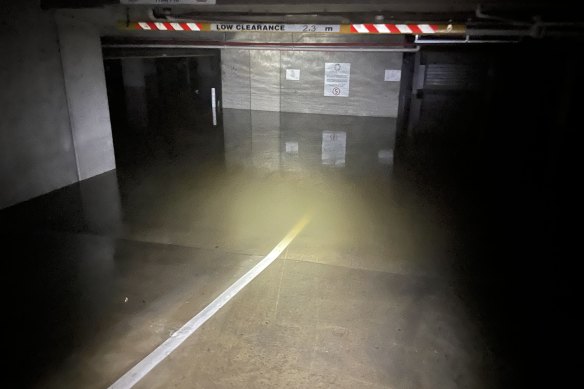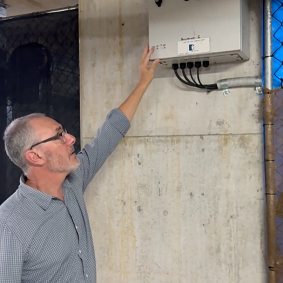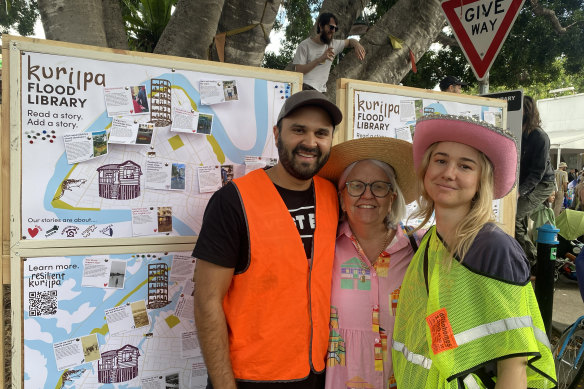- Perspective
- National
- Queensland
- City council
This was published 8 months ago
How one Brisbane community is engineering its own flood response
Residents of Riverpoint Apartments in West End watched as brown, dirty water filled the basement of their unit complex.
By that point, they were helpless to act.

The basement of Riverpoint Apartments during Brisbane’s 2022 flood. Credit: Adrian Sains
Their efforts to move property and relocate cars had been quashed when the power was unexpectedly turned off, cutting access to the lifts and plunging the car park into darkness.
Civil engineer and Riverpoint resident Adrian Sains was among the onlookers questioning the unfolding flooding event in 2022 and wondering what to do next.

Adrian Sains and his group put together a flood mitigation plan that has since become a resource for other apartment complexes.Credit: Resilient Kurilpa
But Sains wasn’t asking this rhetorically.
Drawing on his experience in hydrology and water management, he formed a working group of semi-retired professionals with electrical, hydraulics, civil and structural backgrounds to better understand how the building failed, and to mitigate the impact of future floods.
“I moved to Riverpoint in 2015 ... we knew it had flooded in 2011, but we weren’t aware of the scope of works that had been done to make the building more resilient,” Sains says.
“We flooded again in 2022, so it turned out we were still vulnerable.”
Sains’ experience has lessons for other apartment dwellers across Brisbane, especially in flood-prone suburbs like West End, where high-density developments are helping the city meet its growing housing needs.
Riverpoint is not a high-rise, but it is sizeable: 10 buildings spread over three hectares, with 331 apartments housing about 700 residents.
“The residential buildings themselves have the required flood immunity for the planning scheme, but the basement doesn’t.”
Civil engineer Adrian Sains
“The residential buildings themselves have the required flood immunity for the planning scheme, but the basement doesn’t – or at least didn’t in 2011 and 2022,” Sains says.
So when the basement flooded, it affected the building’s essential services: its power supply, lifts, pumps and fire hydrants.
Sains says one of the group’s key findings was “a missing link between what council aspire to in their development approvals and what’s actually happening on the ground”.
“We are getting commitments from state and city governments that future developments, which are going to be higher … and more dense, that those risks will be mitigated,” Sains says.
“But I don’t see a process by which they’re going to make sure that happens.”
Master Builders Queensland’s manager of building and planning services, Karen Haworth, says developments in flood-prone areas must include flood mitigation in their design and be inspected by a registered engineer after they are built.
“One thing we talk about a lot in any Mother Nature event is that things are designed to … what people think is going to happen,” Haworth says.
“But if Mother Nature throws everything at it from a different angle, it could change that.”
With increasingly volatile natural disasters, that means past mitigation efforts could be made redundant in the future.
Riverpoint has just finished its emergency power works, a quarter-million-dollar investment to improve internal electrical systems and build temporary walls to be activated during a flood.
“That money has come from the residents,” Sains says.
His group put together a flood mitigation plan and presented it to their body corporate, who put it to a vote.

Resilient Kurilpa members (left to right) Sebastian Vanderzeil, Melinda McInturff and Paula Hardie with the Kurilpa Flood Library, which they use to engage and listen to local flood stories.Credit: Resilient Kurilpa
That plan has also been given to Resilient Kurilpa, a community-led response to the 2022 floods, and other body corporate members, property managers and apartment dwellers in flood-affected properties.
“Our learnings can be taken all over the city, and we believe it could be useful where density is going in around Eagle Street, Kangaroo Point, and so on,” Sains says.
West End Community Association and Resilient Kurilpa volunteer Paula Hardie says what works in her neighbourhood may not work for other parts of Brisbane.
“However, it suggests local knowledge and local relationships are integral starting points for strengthening flood responses,” the strategic designer and PhD student says.
“The choice to develop on the Maiwar floodplain has placed a significant load of work on people living in high-density apartments in flood-prone areas to engineer themselves out of some of these impacts.”
Floodplain development has continued to be a contested issue ahead of this weekend’s council election. Party policies vary, and as always, the issue seems to be how to balance the need for housing (especially in areas where it is often cheaper) with the risk of flooding.
And right now, the conversation raises more questions than answers. Is it possible to outdesign a flood-prone city? Can Brisbane’s growth be accommodated without building on floodplains? And who should take responsibility when mitigation efforts fail?
When I ask Sains what has motivated his efforts of the past two years, he says it’s the strength of his community.
“This community is stronger than any other community I’ve lived in, with people who are really supportive of each other,” he says. “That gave me motivation as an engineer to ask what I could do to help.”
Get the inside word on the news, sport, food, people and places Brisbane is talking about. Sign up for our City Talk newsletter here.